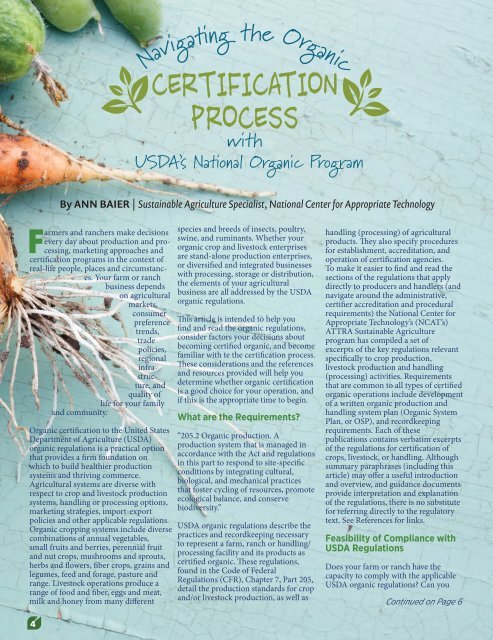OrganicFarmer_AprMayFinal_e
Create successful ePaper yourself
Turn your PDF publications into a flip-book with our unique Google optimized e-Paper software.
By ANN BAIER | Sustainable Agriculture Specialist, National Center for Appropriate Technology<br />
Farmers and ranchers make decisions<br />
every day about production and processing,<br />
marketing approaches and<br />
certification programs in the context of<br />
real-life people, places and circumstances.<br />
Your farm or ranch<br />
business depends<br />
on agricultural<br />
markets,<br />
consumer<br />
preference<br />
trends,<br />
trade<br />
policies,<br />
regional<br />
infrastructure,<br />
and<br />
quality of<br />
life for your family<br />
and community.<br />
Organic certification to the United States<br />
Department of Agriculture (USDA)<br />
organic regulations is a practical option<br />
that provides a firm foundation on<br />
which to build healthier production<br />
systems and thriving commerce.<br />
Agricultural systems are diverse with<br />
respect to crop and livestock production<br />
systems, handling or processing options,<br />
marketing strategies, import-export<br />
policies and other applicable regulations.<br />
Organic cropping systems include diverse<br />
combinations of annual vegetables,<br />
small fruits and berries, perennial fruit<br />
and nut crops, mushrooms and sprouts,<br />
herbs and flowers, fiber crops, grains and<br />
legumes, feed and forage, pasture and<br />
range. Livestock operations produce a<br />
range of food and fiber, eggs and meat,<br />
milk and honey from many different<br />
species and breeds of insects, poultry,<br />
swine, and ruminants. Whether your<br />
organic crop and livestock enterprises<br />
are stand-alone production enterprises,<br />
or diversified and integrated businesses<br />
with processing, storage or distribution,<br />
the elements of your agricultural<br />
business are all addressed by the USDA<br />
organic regulations.<br />
This article is intended to help you<br />
find and read the organic regulations,<br />
consider factors your decisions about<br />
becoming certified organic, and become<br />
familiar with te the certification process.<br />
These considerations and the references<br />
and resources provided will help you<br />
determine whether organic certification<br />
is a good choice for your operation, and<br />
if this is the appropriate time to begin.<br />
What are the Requirements?<br />
“205.2 Organic production. A<br />
production system that is managed in<br />
accordance with the Act and regulations<br />
in this part to respond to site-specific<br />
conditions by integrating cultural,<br />
biological, and mechanical practices<br />
that foster cycling of resources, promote<br />
ecological balance, and conserve<br />
biodiversity.”<br />
USDA organic regulations describe the<br />
practices and recordkeeping necessary<br />
to represent a farm, ranch or handling/<br />
processing facility and its products as<br />
certified organic. These regulations,<br />
found in the Code of Federal<br />
Regulations (CFR), Chapter 7, Part 205,<br />
detail the production standards for crop<br />
and/or livestock production, as well as<br />
handling (processing) of agricultural<br />
products. They also specify procedures<br />
for establishment, accreditation, and<br />
operation of certification agencies.<br />
To make it easier to find and read the<br />
sections of the regulations that apply<br />
directly to producers and handlers (and<br />
navigate around the administrative,<br />
certifier accreditation and procedural<br />
requirements) the National Center for<br />
Appropriate Technology’s (NCAT’s)<br />
ATTRA Sustainable Agriculture<br />
program has compiled a set of<br />
excerpts of the key regulations relevant<br />
specifically to crop production,<br />
livestock production and handling<br />
(processing) activities. Requirements<br />
that are common to all types of certified<br />
organic operations include development<br />
of a written organic production and<br />
handling system plan (Organic System<br />
Plan, or OSP), and recordkeeping<br />
requirements. Each of these<br />
publications contains verbatim excerpts<br />
of the regulations for certification of<br />
crops, livestock, or handling. Although<br />
summary paraphrases (including this<br />
article) may offer a useful introduction<br />
and overview, and guidance documents<br />
provide interpretation and explanation<br />
of the regulations, there is no substitute<br />
for referring directly to the regulatory<br />
text. See References for links.<br />
Feasibility of Compliance with<br />
USDA Regulations<br />
Does your farm or ranch have the<br />
capacity to comply with the applicable<br />
USDA organic regulations? Can you<br />
Continued on Page 6<br />
4<br />
Organic Farmer April/May 2019


















